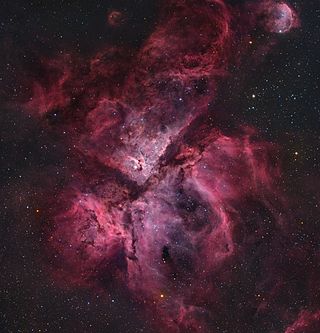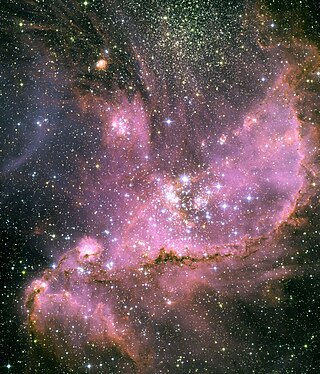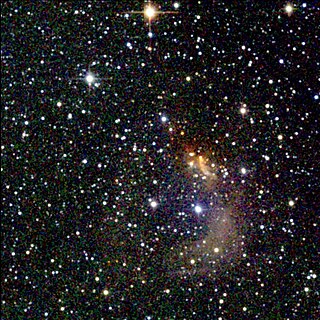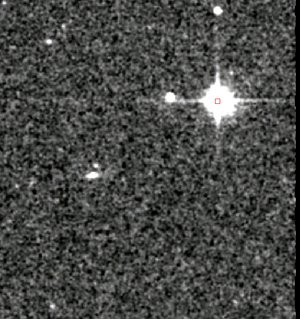
Fornax is a constellation in the southern celestial hemisphere, partly ringed by the celestial river Eridanus. Its name is Latin for furnace. It was named by French astronomer Nicolas Louis de Lacaille in 1756. Fornax is one of the 88 modern constellations.

The New General Catalogue of Nebulae and Clusters of Stars is an astronomical catalogue of deep-sky objects compiled by John Louis Emil Dreyer in 1888. The NGC contains 7,840 objects, including galaxies, star clusters and emission nebulae. Dreyer published two supplements to the NGC in 1895 and 1908, known as the Index Catalogues, describing a further 5,386 astronomical objects. Thousands of these objects are best known by their NGC or IC numbers, which remain in widespread use.

NGC 2264 is the designation number of the New General Catalogue that identifies two astronomical objects as a single object: the Cone Nebula, and the Christmas Tree Cluster. Two other objects are within this designation but not officially included, the Snowflake Cluster, and the Fox Fur Nebula.

The Rosette Nebula is an H II region located near one end of a giant molecular cloud in the Monoceros region of the Milky Way Galaxy. The open cluster NGC 2244 is closely associated with the nebulosity, the stars of the cluster having been formed from the nebula's matter.

The Jewel Box is an open cluster in the constellation Crux, originally discovered by Nicolas Louis de Lacaille in 1751–1752. This cluster was later named the Jewel Box by John Herschel when he described its telescopic appearance as "...a superb piece of fancy jewellery". It is easily visible to the naked eye as a hazy star some 1.0° southeast of the first-magnitude star Mimosa. This hazy star was given the Bayer star designation "Kappa Crucis", from which the cluster takes one of its common names. The modern designation Kappa Crucis has been assigned to one of the stars in the base of the A-shaped asterism of the cluster

The Carina Nebula or Eta Carinae Nebula is a large, complex area of bright and dark nebulosity in the constellation Carina, located in the Carina–Sagittarius Arm of the Milky Way galaxy. The nebula is approximately 8,500 light-years (2,600 pc) from Earth.

NGC 1, also occasionally referred to as GC 1, UGC 57, PGC 564 or Holm 2a is an intermediate spiral galaxy of the morphological type Sbc, located approximately 210 to 215 million light-years from the Solar System in the constellation Pegasus. It was discovered on 30 September 1861 by Heinrich d'Arrest.

NGC 3603 is a nebula situated in the Carina–Sagittarius Arm of the Milky Way around 20,000 light-years away from the Solar System. It is a massive H II region containing a very compact open cluster HD 97950.
Over the past few centuries, a small number of stars have been named after individual people. It is common in astronomy for objects to be given names, in accordance with accepted astronomical naming conventions. Most stars have not been given proper names, relying instead on alphanumeric designations in star catalogues. However, a few hundred had either long-standing traditional names or historic names from frequent usage.

Sh2-279 is an HII region and bright nebulae that includes a reflection nebula located in the constellation Orion. It is the northernmost part of the asterism known as Orion's Sword, lying 0.6° north of the Orion Nebula. The reflection nebula embedded in Sh2-279 is popularly known as the Running Man Nebula.

NGC 6231 is an open cluster in the southern sky located half a degrees north of Zeta Scorpii. NGC 6231 is part of a swath of young, bluish stars in the constellation Scorpius known as the Scorpius OB1 association. The star Zeta1 is a member of this association, while its brighter apparent partner, Zeta2, is only 150 ly from Earth and so is not a member.

NGC 346 is a young open cluster of stars with associated nebula located in the Small Magellanic Cloud (SMC) that appears in the southern constellation of Tucana. It was discovered August 1, 1826 by Scottish astronomer James Dunlop. J. L. E. Dreyer described it as, "bright, large, very irregular figure, much brighter middle similar to double star, mottled but not resolved". On the outskirts of the cluster is the multiple star system HD 5980, one of the brightest stars in the SMC.

NGC 5307 is a planetary nebula in the southern constellation of Centaurus, positioned less than 3° to the northeast of the star Epsilon Centauri. It was discovered by English astronomer John Herschel on April 15, 1836. The nebula is located at a distance of approximately 10.6 kilolight-years from the Sun. The central star, designated PNG 312.3+10.5, is a weak emission-line star, superficially similar to the WC subtype of Wolf–Rayet stars. It has a spectral class of O(H)3.5 V.

NGC 2261 is a variable nebula located in the constellation Monoceros. The nebula is illuminated by the star R Monocerotis, which is not directly visible itself.

An astronomical catalog or catalogue is a list or tabulation of astronomical objects, typically grouped together because they share a common type, morphology, origin, means of detection, or method of discovery. The oldest and largest are star catalogues. Hundreds have been published, including general ones and special ones for such items as infrared stars, variable stars, giant stars, multiple star systems, star clusters, and so forth.

NGC 2129 is an open cluster in the constellation Gemini. It has an angular distance of 2.5 arcminutes and is approximately 2.2 ± 0.2 kpc from the Sun inside the Local spiral arm. At that distance, the angular size of the cluster corresponds to a diameter of about 10.4 light years. NGC 2129 is a very young cluster whose age has been estimated at 10 million years.

NGC 2626 is a reflection nebula, emission nebula, and absorption nebula in the constellation Vela. It is mostly illuminated by B1 star CD-40 4432 and ionized by the O8 quadruple star system HD 73882, together with other stars.

NGC 128 is a lenticular galaxy in the constellation Pisces. It is approximately 190 million light-years from the Sun and has a diameter of about 165,000 light-years.

NGC 5460 is an open cluster in the constellation Centaurus. It is a bright but loose cluster of intermediate age located approximately 2,300 light years away from Earth. It is located nearly 2 degrees east-southeast of Zeta Centauri.


















